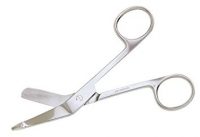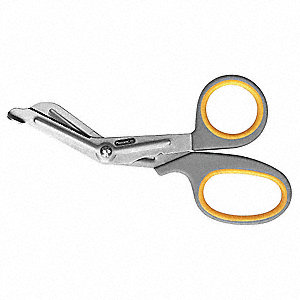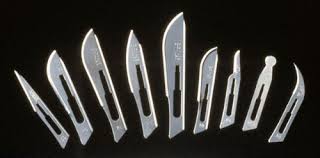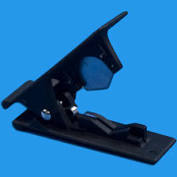Cutting Blood Tubing…..Professionally! – By Gary Grist RN CCP Emeritus
One definition of a professional is a person who performs a task with “great competence.” But I have seen blood tubing cut with “great incompetence” by perfusionists over the years. You might think that I am judgmental if I accuse some (most?) perfusionists of being incompetent when cutting blood tubing, particularly sterile, blood-filled, blood tubing. But being old and retired, I don’t really care if people think I am being judgmental.
When I first started cutting blood tubing back in 1968, we had to pre-cut our circuits. There were no custom, sterilized tubing packs like today. We cut our tubing from long rolls of relatively stiff PVC tubing and latex tubing (used for the pump raceway). After cutting we assembled the circuits with stainless steel connectors (there were no plastic connectors then either), put them in double layered cloth wraps and steam sterilized them for an hour after which the packs needed to air dry for several hours.
We used PVC with a fairly high durometer because it softened up after autoclaving. But cutting the thick, tough tubing before-hand was a chore. Initially, all I had was some old “cast” scissors. These look like ordinary bandage scissors with a blunt tip on the lower blade except that they were much larger and longer. (See Fig. 1) The longer length gave more power and better leverage when cutting cling and plaster cast materials once the cast was in place and the plaster began setting. However, my cast scissors were very old and dull. And the pivot pin was loose, making cutting quite difficult. It was more like “chewing” my way through the tubing rather than cutting through. I asked the equipment room personnel for better scissors, but they refused to give me any. They said that my tough tubing would just ruin them again.

Fig. 1 Bandage scissors
Then one day I was in a hardware store, and I saw a pair of unusual scissors. I asked the clerk about them, and he told me that they were new “flak vest” scissors. The war in Viet Nam was raging then, and the story was that medics hated the piddly bandage scissors issued by the army. The bandage scissors would not cut through the thick flak vest material and heavy equipment webbing worn by the combat soldiers. So some genius came up with these new scissors. (See Fig. 2)

Fig. 2 Flak vest shears
With that explanation, the clerk took a penny from his pocket and cut it in half using a single, easy motion with the scissors. I was impressed, to say the least. I immediately bought a pair for use at work, but they were not cheap. They cost $6. That doesn’t sound like much today, but $6 in 1968 would buy five gallons of gas plus dinner and a movie for both my wife and me.
I took the scissors to work and put them in a drawer in the anteroom where I cut my tubing. Within two weeks, they were stolen. I bought another pair, and soon they were stolen. The third pair I kept on my person or in my locker. Those scissors never dulled or came loose. They worked for the rest of the time I worked at that hospital until we started getting custom packs.
You may ask why I didn’t just use a Bard-Parker blade to cut the tubing because that’s what many perfusionists do even today. (See Fig. 3)

Fig. 3. Bard Parker blades
The answer is I was also trained as a scrub nurse. One of the first lessons is never to touch a blade with your fingers. Always use a clamp to grab the blade and slip it off and on the knife handle. Surgical blades are extraordinarily sharp, sharper than any blade in your home including razor blades. I have seen a knife fall from the OR table and penetrate the shoe laces, leather, lining, sock, skin, and lodge deeply in a metatarsal bone. Holding a naked blade in one’s fingers and cutting through PVC tubing risks accidentally slicing through the palm or even severing a finger. It takes one moment of inattention to perform an accidental self-incision, particularly during a high pressure, urgent situation when the need to cut blood filled tubing is most common.
In all honesty, I have used a blade to cut tubing, but only when I failed to prepare adequately by having appropriate cutting tools available when needed. What I learned over the years is that the motto of perfusionists should be the same as the Boy Scouts; Be Prepared! Eventually, I had utility carts in each room with each CPB pump and jump kits (compact rolling storage bins) with each ECMO pump. Each contained any and all the supplies I would need to address any CPB or ECMO equipment or circuit problem that I could conceive. This included sterile scissors and prep materials for cutting blood tubing. The idea was to eliminate any need to run to the pump store room or send a helper (even if one was available) to get needed supplies; a very unprofessional plan of action.
Even with all this preparation, I was still dissatisfied with using sterile scissors to cut tubing. Many times the scissors were still dull or malfunctioned due to the repeated sterilization. In addition, it was difficult to keep the scissors sterile if more than one cut was needed. Using the peel pack as a sort of holster to keep the scissor blades sterile was less than satisfactory. When our ECMO program started in 1986, I realized that the need to cut blood tubing safely and quickly would become much more frequent, even routine; the need to change out components like oxygenators, raceways or even entire circuits being common.
Then a friend of mine who was a hemodialysis technician at another hospital showed me a Guillotine type of tubing cutter (see Fig. 4).

Fig. 4 Tubing cutter
These work by placing the tubing between two jaws one of which contains a piercing blade which is as sharp as a surgical blade. When the jaws are compressed, the cutter easily severs the tubing cleanly. The cutter can cut PVC tubing up to ¾ inches in diameter. After use, the blade can be replaced with a new sharp blade for the next job. If more than one cut is necessary, the tubing cutter can be placed on any flat surface without contaminating the blade and cutting surfaces, ready for another cut. And since the blade is secure and guarded within the cutter, there is less chance that it can cut the user or be inadvertently misplaced where it could cut a bystander like a lose surgical blade might.
The cutters were only $10 each including five spare blades. I immediately ordered a dozen of these new tubing cutters, sterilized them and placed them in all my CPB utility carts and ECMO jump kits. From 1986 onward I used the cutters safely and repeatedly to change ECMO oxygenators, heat exchangers, and entire circuits. I also used them with CPB circuits, but much less frequently; changing one CPB oxygenator (using a PRONTO line), replacing a split raceway and severing an intact raceway to fit on a centrifugal pump when an arterial roller pump failed during a case. I also used the cutters for much less crucial, non-sterile things like cutting new heater/cooler water lines and sweep gas circuit tubing. Even Biomedical Engineering borrowed some cutters to cut tubing for their ventilators and other equipment.
So if the near future finds you near one of your CPB or ECMO pumps with time for contemplation, ask yourself this question. Do I have everything I need in my ECMO jump kit or my CPB utility cart to emergently cut out and replace a failing oxygenator or replace a split raceway or replace a bad centrifugal pump head without leaving the room for additional supplies or waiting for additional personnel to help me? If the answer is “No!’, then you are gambling with patients’ lives and perhaps your career that such an incident will never occur on your watch. If the answer is “Yes!”, then you can probably cut blood tubing…..professionally!
